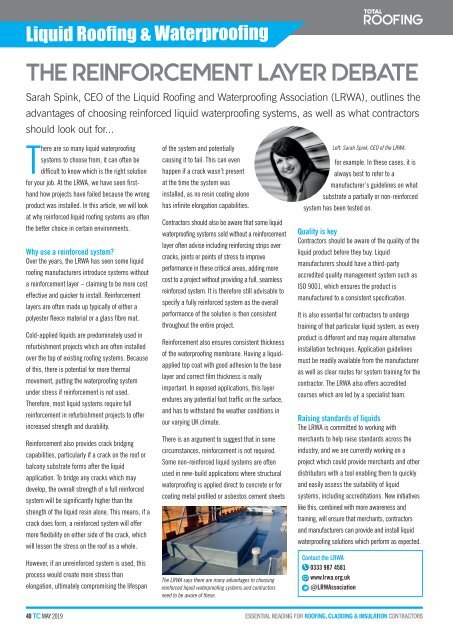May 2019
Create successful ePaper yourself
Turn your PDF publications into a flip-book with our unique Google optimized e-Paper software.
Liquid Roofing & Waterproofing<br />
THE REINFORCEMENT LAYER DEBATE<br />
Sarah Spink, CEO of the Liquid Roofing and Waterproofing Association (LRWA), outlines the<br />
advantages of choosing reinforced liquid waterproofing systems, as well as what contractors<br />
should look out for...<br />
There are so many liquid waterproofing<br />
systems to choose from, it can often be<br />
difficult to know which is the right solution<br />
for your job. At the LRWA, we have seen firsthand<br />
how projects have failed because the wrong<br />
product was installed. In this article, we will look<br />
at why reinforced liquid roofing systems are often<br />
the better choice in certain environments.<br />
Why use a reinforced system?<br />
Over the years, the LRWA has seen some liquid<br />
roofing manufacturers introduce systems without<br />
a reinforcement layer – claiming to be more cost<br />
effective and quicker to install. Reinforcement<br />
layers are often made up typically of either a<br />
polyester fleece material or a glass fibre mat.<br />
Cold-applied liquids are predominately used in<br />
refurbishment projects which are often installed<br />
over the top of existing roofing systems. Because<br />
of this, there is potential for more thermal<br />
movement, putting the waterproofing system<br />
under stress if reinforcement is not used.<br />
Therefore, most liquid systems require full<br />
reinforcement in refurbishment projects to offer<br />
increased strength and durability.<br />
Reinforcement also provides crack bridging<br />
capabilities, particularly if a crack on the roof or<br />
balcony substrate forms after the liquid<br />
application. To bridge any cracks which may<br />
develop, the overall strength of a full reinforced<br />
system will be significantly higher than the<br />
strength of the liquid resin alone. This means, if a<br />
crack does form, a reinforced system will offer<br />
more flexibility on either side of the crack, which<br />
will lessen the stress on the roof as a whole.<br />
However, if an unreinforced system is used, this<br />
process would create more stress than<br />
elongation, ultimately compromising the lifespan<br />
of the system and potentially<br />
causing it to fail. This can even<br />
happen if a crack wasn’t present<br />
at the time the system was<br />
installed, as no resin coating alone<br />
has infinite elongation capabilities.<br />
Contractors should also be aware that some liquid<br />
waterproofing systems sold without a reinforcement<br />
layer often advise including reinforcing strips over<br />
cracks, joints or points of stress to improve<br />
performance in these critical areas, adding more<br />
cost to a project without providing a full, seamless<br />
reinforced system. It is therefore still advisable to<br />
specify a fully reinforced system as the overall<br />
performance of the solution is then consistent<br />
throughout the entire project.<br />
Reinforcement also ensures consistent thickness<br />
of the waterproofing membrane. Having a liquidapplied<br />
top coat with good adhesion to the base<br />
layer and correct film thickness is really<br />
important. In exposed applications, this layer<br />
endures any potential foot traffic on the surface,<br />
and has to withstand the weather conditions in<br />
our varying UK climate.<br />
There is an argument to suggest that in some<br />
circumstances, reinforcement is not required.<br />
Some non-reinforced liquid systems are often<br />
used in new-build applications where structural<br />
waterproofing is applied direct to concrete or for<br />
coating metal profiled or asbestos cement sheets<br />
The LRWA says there are many advantages to choosing<br />
reinforced liquid waterproofing systems and contractors<br />
need to be aware of these.<br />
Contact the LRWA<br />
0333 987 4581<br />
www.lrwa.org.uk<br />
@LRWAssociation<br />
Left: Sarah Spink, CEO of the LRWA.<br />
for example. In these cases, it is<br />
always best to refer to a<br />
manufacturer’s guidelines on what<br />
substrate a partially or non-reinforced<br />
system has been tested on.<br />
Quality is key<br />
Contractors should be aware of the quality of the<br />
liquid product before they buy. Liquid<br />
manufacturers should have a third-party<br />
accredited quality management system such as<br />
ISO 9001, which ensures the product is<br />
manufactured to a consistent specification.<br />
It is also essential for contractors to undergo<br />
training of that particular liquid system, as every<br />
product is different and may require alternative<br />
installation techniques. Application guidelines<br />
must be readily available from the manufacturer<br />
as well as clear routes for system training for the<br />
contractor. The LRWA also offers accredited<br />
courses which are led by a specialist team.<br />
Raising standards of liquids<br />
The LRWA is committed to working with<br />
merchants to help raise standards across the<br />
industry, and we are currently working on a<br />
project which could provide merchants and other<br />
distributors with a tool enabling them to quickly<br />
and easily assess the suitability of liquid<br />
systems, including accreditations. New initiatives<br />
like this, combined with more awareness and<br />
training, will ensure that merchants, contractors<br />
and manufacturers can provide and install liquid<br />
waterproofing solutions which perform as expected.<br />
40 TC MAY <strong>2019</strong>

















